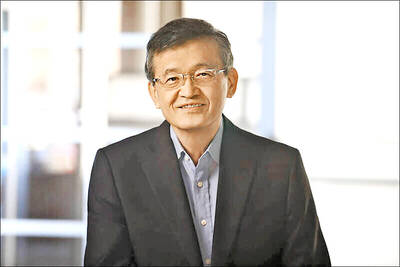The aviation industry is under pressure to do something about the immense amount of carbon emissions its engines generate. The output is accelerating many times faster than from sectors such as energy and agriculture, contributing to global warming.
Paul Eremenko, a 41-old former chief technology officer for Airbus SE and United Technologies Corp, thinks he has a solution: hydrogen-powered airplanes.
Of course, he well understands that his idea has a bit of a public relations problem right from the start. Hydrogen power and flight conjures up visions of the flaming Hindenburg airship.

Photo: AP
Yet his plan, backed by about US$8 million in initial private funding, is to start the transition with a better way to transport hydrogen and store it in the airplane, like a gas tank in a car.
Using hydrogen-powered fuel cells for aircraft is not a new idea. NASA already does and manufacturers have experimented for years with running small planes on them.
However, to become a viable business, planes would require a hydrogen fueling infrastructure that does not exist now — the same problem that has held back fuel-cell cars. Airports accustomed to loading planes with jet fuel lack the hydrogen pipelines and storage facilities to make that vision work.
So Eremenko’s start-up, called Universal Hydrogen Co, has developed Kevlar-coated, pill-shaped pods — about 2m in length and 1m in diameter — filled with hydrogen. The pods are designed to double as a storage container for transporting the hydrogen, by truck, train or other means, and a gas tank when loaded into a plane.
If filled with water, each would hold about 787 liters, and they can be stacked in racks so that 54 would fit inside a standard freight shipping container.
They can even be loaded into a plane with a forklift, he said.
The point is that airports would not need pipelines or underground tanks.
“We want to basically turn hydrogen into dry freight,” Eremenko said.
Universal Hydrogen has no interest in becoming an aircraft maker itself. Instead, starting in 2024, the company plans to offer not just the pods, but a retrofit kit for converting a 50-seat, single-aisle, regional aircraft to run on fuel cells — although making room for the capsules would mean the planes would only have 40 seats after the switch.
The converted planes would exist largely to show the industry how to make this future work.
Eremenko said that he wants the planes in the air before Boeing Co and Airbus decide on designs for replacing their own single-aisle planes, expected to happen in the next decade.
Although Universal Hydrogen would focus on planes with hydrogen fuel cells, the same pods could also one day be used to power planes that burn hydrogen in jet engines.
“There is fundamentally an incrementalist mindset in the incumbents,” Eremenko said. “Hydrogen is a fairly drastic step for the industry. I think it’s a necessary step, given the industry has no other way to meet the goals of the Paris agreement.”
Air travel accounts for about 2.5 percent of global greenhouse gas emissions, and before the pandemic at least, it was steadily growing. While some engineers are developing small electrified aircraft, current batteries are too heavy to power commercial planes on their own.
Airlines have run highly publicized flights on biofuel blends, but Eremenko considers biofuels a stopgap measure, even if they achieve mass production.
“You’re still burning hydrocarbons at altitude, with soot and aerosols,” he said.
Provided the hydrogen is generated from water by electrolysis using renewable power, it can be carbon-free. “Flight shaming” — the avoidance of airline travel due to its carbon footprint and the shaming of people who fly — would become a thing of the past.
Hydrogen has its own challenges to overcome in the air, of course. Ever since the Hindenburg burst into flames while docking in 1937, part of the public has viewed hydrogen warily.
However, its proponents, including companies that have explored hydrogen for powering cars as well as airplanes, consider that fear overblown.
As countless airplane and car crashes have shown, conventional fuels can be quite explosive on their own, and because it is so light, hydrogen rises when accidentally released, rather than pooling as jet fuel does.
Eremenko said that its is safer than jet fuel and believes the public, growing used to hydrogen-powered buses and cars that are already on the road, will get over its aversion.
Former Airbus chief executive officer Tom Enders, who is advising the start-up, said that the main market would be for medium-range, single-aisle aircraft.
While such planes are less commonly used in the US, they constitute the vast majority of aircraft worldwide, he said via e-mail.
“In other words, there is a huge market potential,” Enders said.
Eremenko formed the start-up with other aviation veterans after leaving United Technologies last year. The business has so far been self-funded, with about US$3 million from its core team and US$5 million from partners. To reach production, he estimated Universal Hydrogen would need to raise about US$300 million.
The same hydrogen storage solution, if successful in aviation, could one day be used in other industries, he said.
Cargo ship builders are also exploring fuel cells as a future power source, but Eremenko prefers to start with planes.
“Ultimately, we think aviation is the killer app, because aviation doesn’t have an alternative,” he said. “Also, it’s fun for us, because we’re aviation people.”

Intel Corp chief executive officer Lip-Bu Tan (陳立武) is expected to meet with Taiwanese suppliers next month in conjunction with the opening of the Computex Taipei trade show, supply chain sources said on Monday. The visit, the first for Tan to Taiwan since assuming his new post last month, would be aimed at enhancing Intel’s ties with suppliers in Taiwan as he attempts to help turn around the struggling US chipmaker, the sources said. Tan is to hold a banquet to celebrate Intel’s 40-year presence in Taiwan before Computex opens on May 20 and invite dozens of Taiwanese suppliers to exchange views

Application-specific integrated circuit designer Faraday Technology Corp (智原) yesterday said that although revenue this quarter would decline 30 percent from last quarter, it retained its full-year forecast of revenue growth of 100 percent. The company attributed the quarterly drop to a slowdown in customers’ production of chips using Faraday’s advanced packaging technology. The company is still confident about its revenue growth this year, given its strong “design-win” — or the projects it won to help customers design their chips, Faraday president Steve Wang (王國雍) told an online earnings conference. “The design-win this year is better than we expected. We believe we will win

Quanta Computer Inc (廣達) chairman Barry Lam (林百里) is expected to share his views about the artificial intelligence (AI) industry’s prospects during his speech at the company’s 37th anniversary ceremony, as AI servers have become a new growth engine for the equipment manufacturing service provider. Lam’s speech is much anticipated, as Quanta has risen as one of the world’s major AI server suppliers. The company reported a 30 percent year-on-year growth in consolidated revenue to NT$1.41 trillion (US$43.35 billion) last year, thanks to fast-growing demand for servers, especially those with AI capabilities. The company told investors in November last year that

Power supply and electronic components maker Delta Electronics Inc (台達電) yesterday said it plans to ship its new 1 megawatt charging systems for electric trucks and buses in the first half of next year at the earliest. The new charging piles, which deliver up to 1 megawatt of charging power, are designed for heavy-duty electric vehicles, and support a maximum current of 1,500 amperes and output of 1,250 volts, Delta said in a news release. “If everything goes smoothly, we could begin shipping those new charging systems as early as in the first half of next year,” a company official said. The new